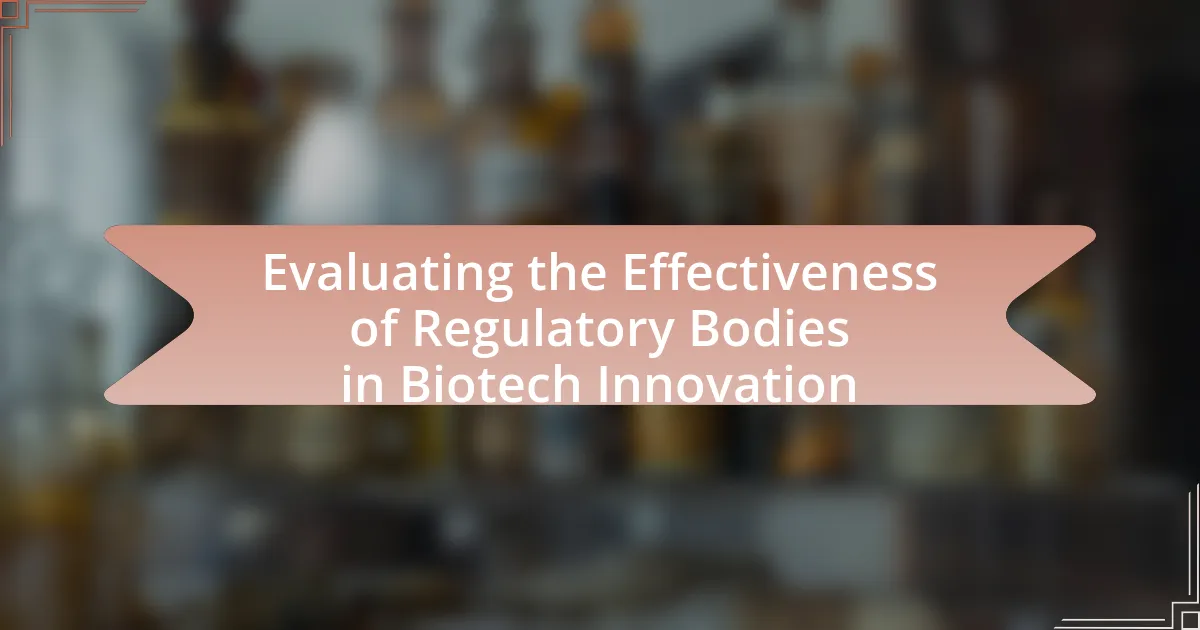Regulatory bodies, such as the U.S. Food and Drug Administration (FDA) and the European Medicines Agency (EMA), play a crucial role in overseeing biotech innovation by ensuring the safety, efficacy, and ethical standards of biotechnological products. This article evaluates the effectiveness of these regulatory entities, examining their influence on biotech innovation, the challenges they face, and the metrics used to assess their performance. It also discusses the importance of transparency, stakeholder engagement, and the impact of evolving technologies on regulatory frameworks. Furthermore, the article highlights future trends in regulatory practices and practical steps stakeholders can take to support effective regulation in the biotech sector.

What are Regulatory Bodies in Biotech Innovation?
Regulatory bodies in biotech innovation are governmental or independent organizations responsible for overseeing and ensuring the safety, efficacy, and ethical standards of biotechnological products and processes. These entities, such as the U.S. Food and Drug Administration (FDA) and the European Medicines Agency (EMA), establish guidelines and regulations that biotech companies must follow during research, development, and commercialization phases. Their role is critical in protecting public health and maintaining scientific integrity, as evidenced by their rigorous evaluation processes that include clinical trials and post-market surveillance to assess the impact of biotech innovations on society.
How do Regulatory Bodies influence Biotech Innovation?
Regulatory bodies influence biotech innovation by establishing guidelines and standards that govern research, development, and commercialization processes. These regulations ensure safety, efficacy, and ethical considerations, which can either facilitate or hinder innovation. For instance, the U.S. Food and Drug Administration (FDA) requires rigorous clinical trials before approving new biotech products, which can extend the time and cost of bringing innovations to market. However, clear regulatory frameworks can also provide a pathway for companies to navigate the complex landscape of biotech, encouraging investment and research. According to a report by the Biotechnology Innovation Organization, regulatory clarity can lead to increased funding and faster development timelines, demonstrating that effective regulation can enhance innovation while maintaining public safety.
What roles do Regulatory Bodies play in the biotech sector?
Regulatory bodies play a crucial role in the biotech sector by ensuring the safety, efficacy, and quality of biotechnological products. They establish guidelines and regulations that govern the research, development, and commercialization of biotech innovations, which include pharmaceuticals, agricultural products, and medical devices. For instance, the U.S. Food and Drug Administration (FDA) evaluates new drugs and therapies through rigorous clinical trials to assess their safety and effectiveness before approval. This process is vital for protecting public health and maintaining consumer trust in biotech products. Additionally, regulatory bodies monitor compliance with established standards and can enforce penalties for violations, thereby promoting accountability within the industry.
How do Regulatory Bodies ensure safety and efficacy in biotech products?
Regulatory bodies ensure safety and efficacy in biotech products through rigorous evaluation processes, including preclinical and clinical trials, which assess the product’s safety, effectiveness, and quality. These bodies, such as the U.S. Food and Drug Administration (FDA) and the European Medicines Agency (EMA), require extensive data from manufacturers demonstrating that biotech products meet established safety and efficacy standards before they can be approved for public use. For instance, the FDA mandates that companies conduct Phase I, II, and III clinical trials to gather data on the product’s effects in humans, ensuring that any potential risks are identified and mitigated. Additionally, regulatory bodies continuously monitor approved products through post-marketing surveillance to ensure ongoing compliance with safety standards, thereby reinforcing their commitment to public health.
Why is the effectiveness of Regulatory Bodies important?
The effectiveness of regulatory bodies is crucial because it ensures the safety, efficacy, and quality of biotech innovations. Regulatory bodies, such as the FDA and EMA, establish guidelines and standards that govern the development and approval of biotechnological products. Their effectiveness directly impacts public health by preventing unsafe or ineffective products from reaching the market, as evidenced by the rigorous approval processes that have led to the successful introduction of life-saving therapies. For instance, the FDA’s approval of the mRNA COVID-19 vaccines was based on stringent evaluation criteria that demonstrated their safety and efficacy, highlighting the importance of regulatory oversight in protecting consumers and fostering innovation in the biotech sector.
What metrics are used to evaluate the effectiveness of Regulatory Bodies?
Regulatory bodies are evaluated based on metrics such as compliance rates, time to approval, stakeholder satisfaction, and the incidence of regulatory breaches. Compliance rates measure how well organizations adhere to regulations, while time to approval assesses the efficiency of the regulatory process in granting necessary permissions for biotech innovations. Stakeholder satisfaction gauges the perceptions of those affected by regulations, including industry players and the public. The incidence of regulatory breaches indicates the effectiveness of oversight and enforcement mechanisms. These metrics provide a comprehensive view of a regulatory body’s performance in fostering innovation while ensuring safety and compliance.
How does the effectiveness of Regulatory Bodies impact public trust in biotech?
The effectiveness of Regulatory Bodies significantly enhances public trust in biotech by ensuring safety, efficacy, and ethical standards in biotechnological products and practices. When regulatory agencies, such as the FDA or EMA, demonstrate rigorous evaluation processes and transparent decision-making, they foster confidence among the public that biotech innovations are thoroughly vetted. For instance, a survey conducted by the Pew Research Center in 2020 indicated that 88% of Americans believe that government oversight is essential for ensuring the safety of genetically modified foods. This statistic underscores the correlation between effective regulation and public assurance in biotech advancements.

What challenges do Regulatory Bodies face in Biotech Innovation?
Regulatory bodies face significant challenges in biotech innovation, primarily due to the rapid pace of technological advancements and the complexity of biological systems. These organizations must navigate evolving scientific knowledge while ensuring public safety and compliance with existing regulations. For instance, the introduction of CRISPR technology has outpaced regulatory frameworks, creating uncertainty in governance. Additionally, regulatory bodies often struggle with limited resources and expertise to evaluate novel therapies, which can lead to delays in approval processes. The need for international harmonization of regulations further complicates their efforts, as differing standards across countries can hinder global collaboration and innovation.
How do evolving technologies affect Regulatory Bodies?
Evolving technologies significantly impact regulatory bodies by necessitating updates to existing frameworks and guidelines to ensure safety and compliance. As innovations such as gene editing, artificial intelligence, and biotechnology advance, regulatory bodies must adapt their processes to evaluate new products and practices effectively. For instance, the rapid development of CRISPR technology has prompted agencies like the FDA and EMA to reconsider their regulatory approaches, leading to the establishment of new guidelines that address the unique challenges posed by such technologies. This adaptation is crucial for maintaining public trust and ensuring that innovations do not outpace regulatory oversight, which can lead to potential risks in health and safety.
What are the implications of rapid biotech advancements on regulation?
Rapid advancements in biotechnology necessitate adaptive regulatory frameworks to ensure safety, efficacy, and ethical standards. As biotech innovations, such as CRISPR and gene therapies, evolve quickly, existing regulations often lag behind, creating gaps in oversight. For instance, the U.S. Food and Drug Administration (FDA) has had to revise its guidelines to accommodate novel therapies, reflecting the need for a more dynamic regulatory approach. This situation underscores the importance of continuous dialogue between innovators and regulators to address emerging challenges, such as bioethics and public health implications, ensuring that regulations keep pace with technological progress.
How do Regulatory Bodies adapt to new scientific discoveries?
Regulatory bodies adapt to new scientific discoveries by updating guidelines, revising approval processes, and engaging in continuous dialogue with the scientific community. For instance, the U.S. Food and Drug Administration (FDA) has established frameworks like the Breakthrough Therapy designation to expedite the development of innovative therapies based on emerging scientific evidence. This approach allows for more flexible regulatory pathways that can accommodate rapid advancements in biotechnology, ensuring that safety and efficacy standards are maintained while fostering innovation. Additionally, regulatory bodies often collaborate with researchers and industry stakeholders to incorporate the latest scientific findings into their regulatory frameworks, as seen in the FDA’s collaboration with the National Institutes of Health (NIH) on gene therapy regulations.
What are the common criticisms of Regulatory Bodies in Biotech?
Common criticisms of regulatory bodies in biotech include perceived inefficiency, lack of transparency, and overly stringent regulations that can stifle innovation. Critics argue that lengthy approval processes delay the introduction of potentially life-saving therapies, as seen in the case of gene therapies that can take years to receive approval despite promising clinical trial results. Additionally, the opaque nature of decision-making processes raises concerns about accountability and public trust. Furthermore, some regulations are viewed as excessively cautious, which can hinder the rapid advancement of biotechnology, particularly in fast-evolving fields like synthetic biology and personalized medicine. These criticisms highlight the ongoing debate about balancing safety and innovation in the biotech sector.
How do delays in regulation affect biotech innovation?
Delays in regulation hinder biotech innovation by prolonging the time it takes for new therapies and technologies to reach the market. This extended timeline can lead to increased costs for biotech companies, as they must allocate resources to navigate prolonged regulatory processes. For instance, a study by the Tufts Center for the Study of Drug Development found that the average time for drug approval can exceed 10 years, which can stifle investment and slow down the pace of scientific advancement. Furthermore, delays can result in missed opportunities for patients who could benefit from new treatments, ultimately affecting public health outcomes.
What are the concerns regarding transparency and accountability?
Concerns regarding transparency and accountability in the context of regulatory bodies in biotech innovation include the potential for conflicts of interest, lack of public access to decision-making processes, and insufficient oversight mechanisms. Regulatory bodies may face pressure from industry stakeholders, leading to biased decisions that prioritize corporate interests over public health and safety. For instance, a report by the U.S. Government Accountability Office highlighted that inadequate transparency in regulatory processes can undermine public trust and hinder effective oversight. Furthermore, the absence of clear accountability measures can result in a lack of consequences for regulatory failures, which can have significant implications for innovation and consumer safety.

How can the effectiveness of Regulatory Bodies be improved?
The effectiveness of Regulatory Bodies can be improved by enhancing transparency and stakeholder engagement. Increased transparency allows for clearer communication of regulatory processes and decisions, fostering trust among stakeholders. For instance, the FDA has implemented initiatives to involve public input in its decision-making processes, which has led to more informed regulations. Additionally, adopting risk-based approaches can streamline regulatory processes, as seen in the European Medicines Agency’s guidelines, which prioritize resources for higher-risk products. These strategies not only improve regulatory efficiency but also ensure that the needs and concerns of the biotech industry and the public are adequately addressed.
What best practices can enhance regulatory processes?
Implementing transparent communication is a best practice that can enhance regulatory processes. Transparency fosters trust between regulatory bodies and stakeholders, leading to more effective collaboration and compliance. For instance, the FDA’s initiative to increase public engagement through open meetings and stakeholder consultations has improved the clarity of regulatory expectations and reduced the time for approvals in biotech innovations. Additionally, adopting risk-based approaches allows regulators to prioritize resources effectively, focusing on areas with the highest potential impact, as evidenced by the European Medicines Agency’s implementation of adaptive pathways for drug development. These practices not only streamline regulatory processes but also promote innovation while ensuring safety and efficacy.
How can collaboration between stakeholders improve regulation?
Collaboration between stakeholders can improve regulation by fostering a comprehensive understanding of industry needs and challenges. When regulatory bodies, industry representatives, and other stakeholders engage in dialogue, they can identify gaps in existing regulations and develop more effective frameworks that promote innovation while ensuring safety and compliance. For instance, the FDA’s collaboration with biotech companies has led to streamlined approval processes, as seen in the expedited pathways for breakthrough therapies, which have resulted in faster patient access to critical treatments. This collaborative approach not only enhances regulatory efficiency but also builds trust among stakeholders, leading to more robust and adaptive regulatory environments.
What role does public engagement play in regulatory effectiveness?
Public engagement significantly enhances regulatory effectiveness by fostering transparency and trust between regulatory bodies and stakeholders. Engaging the public allows for diverse perspectives, which can lead to more informed decision-making and better regulatory outcomes. For instance, studies have shown that when regulatory agencies incorporate public input, they can identify potential issues earlier and adapt regulations to better meet societal needs, ultimately leading to more effective governance in sectors like biotech.
What are the future trends in regulatory practices for Biotech Innovation?
Future trends in regulatory practices for biotech innovation include increased emphasis on adaptive regulatory frameworks, enhanced collaboration between regulatory bodies and industry stakeholders, and the integration of real-world evidence in decision-making processes. Adaptive frameworks allow for more flexible and responsive regulations that can keep pace with rapid technological advancements in biotechnology. Collaboration is being fostered through initiatives like public-private partnerships, which aim to streamline the approval process and ensure that regulations are informed by the latest scientific developments. Additionally, the use of real-world evidence, such as data from post-market surveillance, is becoming more prevalent, enabling regulators to make informed decisions based on actual product performance rather than solely on pre-market clinical trials. These trends are supported by ongoing discussions in regulatory circles, such as those highlighted in the FDA’s Innovation Strategy and the European Medicines Agency’s initiatives to modernize regulatory approaches.
How might technology reshape regulatory frameworks?
Technology can reshape regulatory frameworks by enabling real-time data collection and analysis, which enhances compliance monitoring and decision-making processes. For instance, the use of blockchain technology can provide transparent and immutable records of transactions, improving traceability in biotech products. Additionally, artificial intelligence can analyze vast datasets to identify trends and potential risks, allowing regulators to adapt policies proactively. The integration of these technologies has been shown to streamline regulatory processes, as evidenced by the FDA’s use of digital tools to expedite drug approvals, demonstrating that technology can lead to more efficient and responsive regulatory environments.
What innovations are being considered to streamline regulatory processes?
Innovations being considered to streamline regulatory processes include the implementation of digital platforms for real-time data sharing and the use of artificial intelligence for risk assessment. Digital platforms enhance transparency and efficiency by allowing stakeholders to access and submit necessary documentation electronically, reducing processing times. AI technologies can analyze vast datasets to identify potential risks and streamline decision-making, thereby expediting the approval process. These innovations are supported by case studies demonstrating reduced timelines in regulatory approvals when digital tools and AI are utilized, such as the FDA’s use of AI in drug review processes, which has shown to decrease review times significantly.
What practical steps can stakeholders take to support effective regulation?
Stakeholders can support effective regulation by actively engaging in collaborative dialogue with regulatory bodies. This engagement can include providing data and insights from industry practices, which helps regulators understand the practical implications of regulations. For instance, stakeholders can participate in public consultations and workshops organized by regulatory agencies, ensuring that their perspectives and expertise inform regulatory frameworks. Additionally, stakeholders can invest in training programs for both industry professionals and regulators to enhance understanding of emerging technologies and regulatory challenges. This approach fosters a shared knowledge base, ultimately leading to more informed and effective regulatory decisions.


